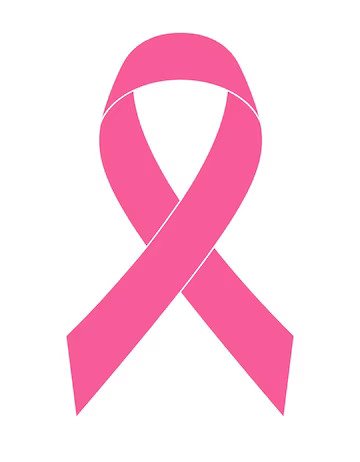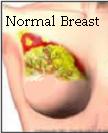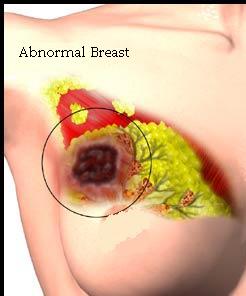Contents
- What Causes Breast Cancer?
- Questions for the Doctor?
- Early Detention and Screening
- What to Look for in Breast Self-examination
- Is there Anything I Can do to Reduce My Risk of Breast Cancer?
Breast Cancer is the most frequently diagnosed cancer in women. Deaths caused by breast cancer have been declining over the past number of years and this is thought to be a result of breast cancer screening programs and improved cancer treatments.
What Causes Breast Cancer?
Cancer occurs when, for an unknown reason, cells divide without control or order o eventually create a tumor.
- The tendency to have cells that become cancerous can be inherited
- The risk of breast cancer increases with age
- Women who have been exposed to estrogen the longest (e.g. early menstruation or late menopause) have a slightly higher risk of breast cancer
- Women who take supplemental synthetic estrogen plus progesterone tablets for several years are at a slightly increased risk of breast cancer
Tumors can either ‘benign’ or ‘malignant’. Benign tumors do not spread outside of the tissue that they are located in, whereas malignant tumors can spread cancer to other parts of the body such as the bones or liver. Eight out of ten breast growths are noncancerous. It is extremely important to catch any growths at the earliest stage in case they are cancerous.
Questions for the Doctor?
Often it is difficult to know what to ask the doctor. Writing down your questions before you go will ensure that you don’t forget anything.
Some questions you might want to ask are listed below:
- What is the exact type of cancer I have?
- Has my cancer spread to lymph nodes or organs?
- What stage is my cancer at? What does that mean?
- What treatment choices do I have? What do you recommend and why?
- What are the chances of my cancer coming back?
- How long will each course of treatment last?
- Will I need to be off work? If so, for how long?
- Should I follow a special diet?
- What kinds of breast reconstruction are possible in my case?
- Will I go through menopause as a result of any treatment?
- What should I do to get ready for treatment?
- Will I loose hair? If so, what can I do about it?
Early Detention and Screening
Treatment of breast cancer is more successful if it caught in the early stages.
Mammography (an-x-ray that can show changes inside the breast) you should do this test every two years between the ages of 50 to 60. Clinical breast examination by a trained health professional at least every two years, and regular breast self- examination.
What to Look for in Breast Self-examination
If you notice any of the following warning signs you should see your doctor right away:
- Puckering (dimpling) of the skin on the breast or around the nipple
- The appearance of patterned skin (like an orange peel) that may be off colour or normal. But the pores stick out
- Any place in your breasts that feels lumpy like a pea, or that is thick and harder than the rest
- Bleeding or discharge from the nipples or crusting
- Tenderness or pain in the breasts, or discharge is usually a benign condition but should checked by your doctor just in case
Note: Breast self-examination should not be uses as a substitute for mammography or clinical breast examinations.
There are four types of standard treatment for breast cancer. They include:
Surgery – Most women with breast cancer have surgery (a lumpectomy or mastectomy) to remove the cancer from the breast. A lumpectomy involves removal of tumor and a small amount of normal tissue around it.
Mastectomy involves removal of the cancer, some or all of the breast tissue around it, and the lining over the chest muscles below the tumor. In cases where the cancer has spread to the chest muscles all the affected chest muscle is removed.
Some of the lymph nodes under the arm are usually removed and examined under a microscope to see if they contain cancer cells. Breast reconstruction (surgery to rebuild a breast’s shape) may be considered after mastectomy.
Radiation therapy – The technique involves the use of x-rays or other types of radiation to kill cancer cells and shrink tumors. Radiation may be delivered by rays from a machine, or materials that produce radiation may be placed inside thin plastic tubes into the area where cancer cells are found. Radiation (in addition to chemotherapy and hormone therapy) may be used after surgery.
Chemotherapy – Certain drugs can kill cancer cells. Some chemotherapy drugs are taken by mouth and others are injected. Because chemotherapy kills some normal cells as well as cancer cells, it can cause associated side effects (e.g. hair loss, reduction in blood cells, mouth sores). It can also cause nausea in some cases, which can be controlled in large measure by anti- nausea medications.
Hormone Therapy – Estrogen and Progesterone can promote the growth of certain types of breast cancer. Medications such as tamoxifen are uses to block the effects of hormones on breast cancer issue. Any vaginal bleeding other than menstrual bleeding should be promptly reported while taking these types of medication.
Is there Anything I Can do to Reduce My Risk of Breast Cancer?
Although there is no proven method of preventing breast cancer, the following strategies may reduce risk:
- Studies suggest that people who eat more fruits and vegetables are at reduced risk of breast cancer.
- Maintain a healthy weight and adopt a healthy lifestyle by avoiding smoking and alcohol or only drinking it in moderation.
- Whether diets high in fat increase risk of breast cancer is still a matter of research. Some studies suggest that higher intake of red meat and fried meat is associated with increase risk of breast cancer.
- Studies of Asian women suggest tat diets high in SOY products result in reduced risk of breast cancer. The benefits are thought to be derived from chemicals called isoflavones that are present in soy.
- In a large long-term study, women who exercised for at least one hour a day reduced their breast cancer risk by 18% compared to those who didn’t exercise as much.
Written by: Winter Rose
Copyright © by www.siyalla.com
[Earlier our website was www.ehealthut.com]




